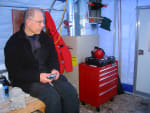The Commission on Astroparticle Physics of the International Union of Pure and Applied Physics (IUPAP) has awarded the 2017 O’Ceallaigh Medal to Christian Spiering, an IceCube collaborator and a researcher at DESY-Zeuthen, for his “outstanding contributions to cosmic ray physics and to the newly emerging field of neutrino astronomy in particular.” Spiering will receive the award during the International Cosmic Ray Conference (ICRC), in July 2017, in Busan, South Korea. […]
Aya Ishihara wins Saruhashi Prize
Aya Ishihara, an IceCube collaborator and an associate professor of physics at Chiba University in Japan, has been awarded the 37th annual Saruhashi Prize, given each year to a female researcher in the natural sciences. This award recognizes women scientists under 50 for exceptional research accomplishments and for mentoring of other women scientists. […]
Week 14 at the Pole
Another amazing week at the Pole—not only was the detector performing well but the twilight photographs continued to be stunning. IceCube winterover Martin captured another great time-lapse shot of a NOAA weather balloon launch along with some striking images of the station and the IceCube Lab. […]
Len Shulman (1950-2017)
Subir Sarkar recognized with the Homi Bhabha Award
The International Union of Pure and Applied Physics (IUPAP) and the Tata Institute of Fundamental Research (TIFR) in Mumbai, India have given the 2017 Homi Bhabha Award to Subir Sarkar, an IceCube collaborator and a professor of physics at both the universities of Oxford and Copenhagen, for his “distinguished contributions in the field of high energy cosmic ray physics and astro-particle physics over an extended academic career.” Prof. Sarkar will receive the award certificate and medal during the inauguration session of the International Cosmic Ray Conference, on July 20, 2017, in Busan, South Korea. […]
Week 13 at the Pole
The sun has set, they’ve held their traditional sunset dinner, and yet … it’s still light outside. Well, that’s twilight. Even after the sun falls below the horizon, the scattering of light in the upper atmosphere illuminates the lower atmosphere and the Earth’s surface. […]
Searching for neutrino emission from 3D-localized gravitational wave sources
The IceCube, ANTARES, Virgo and LIGO collaborations have joined efforts to look for neutrino emission from the second gravitational wave (GW) event as well as from a previous GW candidate. IceCube and ANTARES searched for neutrinos in temporal coincidence and from the directional constraints provided by LIGO. Within 500 seconds around the two GW signals, no neutrino events were found that come within from the signal region in either detector. These results have recently been submitted to Physical Review D. […]
Benjamin Jones awarded APS’s Mitsuyoshi Tanaka Dissertation Award
The American Physical Society has awarded Benjamin Jones, an IceCube collaborator and an assistant professor of physics at the University of Texas at Arlington, the Mitsuyoshi Tanaka Dissertation Award in Experimental Particle Physics, which is widely considered the most prestigious dissertation award in the field. […]
Week 12 at the Pole
This photo at sunset is a picture that paints a thousand words, reminding us that the South Pole is technically a desert. The windswept snow forms into sastrugi, or sharp, irregular grooves and ridges on the hard snow surface. They can create interesting shapes and take on strange appearances, sometimes looking a bit like waves crashing to shore. […]
Week 11 at the Pole
Pull up a chair—sunset at the South Pole takes weeks, not hours. And why is that? Because the Earth’s rotational axis is tilted, the poles gradually proceed from full exposure to full shadow (and back again) as the Earth travels around the sun. […]









